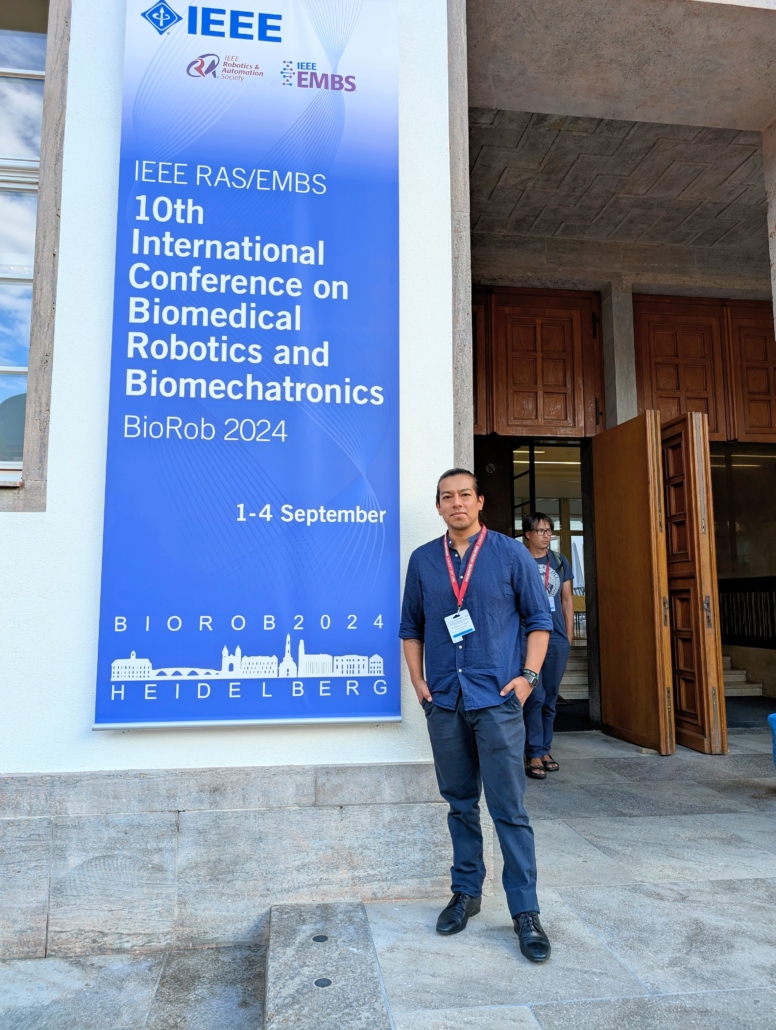B-CRATOS at the 10th iteration of the 𝐈𝐄𝐄𝐄 𝐈𝐧𝐭𝐞𝐫𝐧𝐚𝐭𝐢𝐨𝐧𝐚𝐥 𝐂𝐨𝐧𝐟𝐞𝐫𝐞𝐧𝐜𝐞 𝐨𝐧 𝐁𝐢𝐨𝐦𝐞𝐝𝐢𝐜𝐚𝐥 𝐑𝐨𝐛𝐨𝐭𝐢𝐜𝐬 𝐚𝐧𝐝 𝐁𝐢𝐨𝐦𝐞𝐜𝐡𝐚𝐭𝐫𝐨𝐧𝐢𝐜𝐬 – 𝐁𝐢𝐨𝐑𝐨𝐛𝟐𝟎𝟐𝟒
Between 1 and 4 September 2024, the 10th IEEE International Conference on Biomedical Robotics and Biomechatronics held in Heidelberg, Germany. This conference aims to highlight the theoretical and practical challenges linked with the integration of robotics and mechatronics into medicine and biology.
In particular, our colleague Robinson Guachi from Scuola Superiore Sant’Anna participated with the paper “𝐌𝐞𝐜𝐡𝐚𝐧𝐢𝐜𝐚𝐥 𝐈𝐧𝐭𝐞𝐠𝐫𝐚𝐭𝐢𝐨𝐧 𝐨𝐟 𝐚 𝐒𝐞𝐧𝐬𝐨𝐫𝐢𝐳𝐞𝐝 𝐒𝐤𝐢𝐧 𝐢𝐧 𝐚𝐧 𝐀𝐧𝐭𝐡𝐫𝐨𝐩𝐨𝐦𝐨𝐫𝐩𝐡𝐢𝐜 𝐇𝐚𝐧𝐝: 𝐃𝐞𝐬𝐢𝐠𝐧 𝐩𝐢𝐩𝐞𝐥𝐢𝐧𝐞 𝐚𝐧𝐝 𝐭𝐞𝐬𝐭𝐬”. Here the summary of such an amazing presentation:
Human ability to manipulate and grasp objects relies heavily on tactile information from the skin, which the brain uses to guide motor actions. With advancements in neuroprosthetics, there is growing interest in integrating advanced tactile sensors into prosthetic hands. The paper presented during the conference, supported by the European B-Cratos project, proposes a systematic approach for designing and integrating triboelectric-based electronic skin (e-skin) into a prosthetic hand. It outlines the identification of technical requirements, material selection for soft skin, and optimization of sensor placement on the finger. 



Leave a Reply
Want to join the discussion?Feel free to contribute!